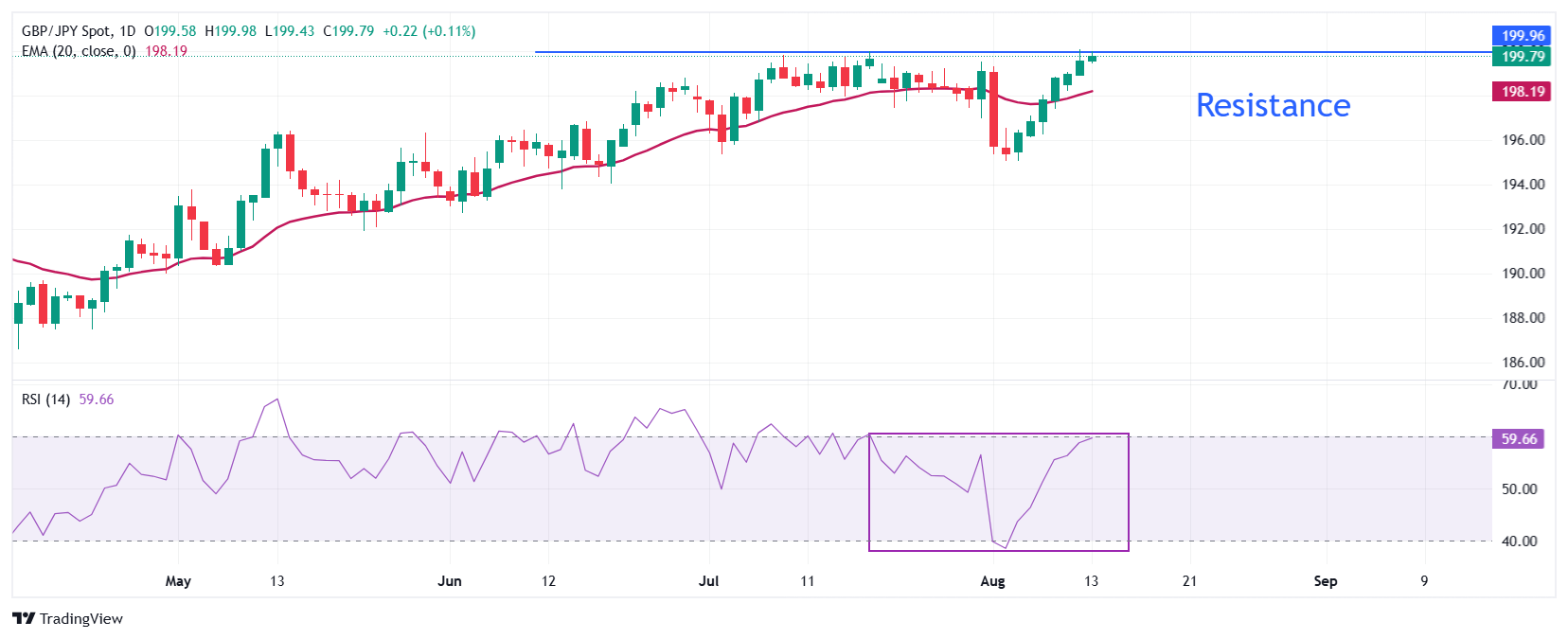GBP/JPY Price Forecast: Sees more upside above 200.00
- GBP/JPY demonstrates strength around 200.00 as the Pound Sterling performs strongly.
- Investors await key preliminary UK Q2 GDP data.
- BoJ officials warn of global trade risk despite US-Japan trade agreement confirmation.
The GBP/JPY pair trades firmly near the psychological level of 200.00 during the European trading session on Wednesday. The pair revisited the 200.00 level on Tuesday as the Pound Sterling (GBP) strengthened after the release of the United Kingdom (UK) labor market data for three-months ending June.
The report showed that the Unemployment Rate remains steady at 4.7%, as expected. Also, Average Earnings Excluding Bonuses grew 5%, in line with estimates and the prior release.
Going forward, investors will focus on the preliminary Q2 Gross Domestic Product (GDP) and factory data for June, which will be published on Thursday. Economists expect the UK economy to have barely grown in the last quarter of the year. The GDP growth rate is seen at 0.1%, against a 0.7% increase in the first quarter.
Meanwhile, the Japanese Yen (JPY) underperforms broadly as investors doubt the Bank of Japan (BoJ) to raise interest rates again this year. The BoJ Summary of Opinions showed that officials are concerned about the economic outlook due to tariffs imposed by the United States (US) economy, even as Tokyo and Washington have reached a trade agreement.
GBP/JPY extends its over-a-week long recovery move from 195.00 to near 200.00. The near-term trend of the cross is bullish as it holds above the 20-day Exponential Moving Average (EMA), which trades around 198.18.
The 14-day Relative Strength Index (RSI) rises to near 60.00. A fresh bullish momentum would emerge if the RSI breaks above that level.
The pair could extend its upside towards 23 July 2024 high of 203.16 and 205.00 if it breaks above the psychological level of 200.00.
On the flip side, a downside move by the pair below the May 6 low of 190.33 will expose it to the March 11 low of 188.80, followed by the February 7 low of 187.00.
GBP/JPY daily chart

Pound Sterling FAQs
The Pound Sterling (GBP) is the oldest currency in the world (886 AD) and the official currency of the United Kingdom. It is the fourth most traded unit for foreign exchange (FX) in the world, accounting for 12% of all transactions, averaging $630 billion a day, according to 2022 data. Its key trading pairs are GBP/USD, also known as ‘Cable’, which accounts for 11% of FX, GBP/JPY, or the ‘Dragon’ as it is known by traders (3%), and EUR/GBP (2%). The Pound Sterling is issued by the Bank of England (BoE).
The single most important factor influencing the value of the Pound Sterling is monetary policy decided by the Bank of England. The BoE bases its decisions on whether it has achieved its primary goal of “price stability” – a steady inflation rate of around 2%. Its primary tool for achieving this is the adjustment of interest rates. When inflation is too high, the BoE will try to rein it in by raising interest rates, making it more expensive for people and businesses to access credit. This is generally positive for GBP, as higher interest rates make the UK a more attractive place for global investors to park their money. When inflation falls too low it is a sign economic growth is slowing. In this scenario, the BoE will consider lowering interest rates to cheapen credit so businesses will borrow more to invest in growth-generating projects.
Data releases gauge the health of the economy and can impact the value of the Pound Sterling. Indicators such as GDP, Manufacturing and Services PMIs, and employment can all influence the direction of the GBP. A strong economy is good for Sterling. Not only does it attract more foreign investment but it may encourage the BoE to put up interest rates, which will directly strengthen GBP. Otherwise, if economic data is weak, the Pound Sterling is likely to fall.
Another significant data release for the Pound Sterling is the Trade Balance. This indicator measures the difference between what a country earns from its exports and what it spends on imports over a given period. If a country produces highly sought-after exports, its currency will benefit purely from the extra demand created from foreign buyers seeking to purchase these goods. Therefore, a positive net Trade Balance strengthens a currency and vice versa for a negative balance.
